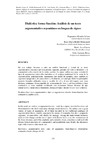| dc.contributor.author | Morales López, Esperanza | |
| dc.contributor.author | Boldú Menasanch, Rosa María | |
| dc.contributor.author | Asta García, María | |
| dc.contributor.author | Garrusta Ribes, Júlia | |
| dc.date.accessioned | 2024-07-15T15:16:54Z | |
| dc.date.available | 2024-07-15T15:16:54Z | |
| dc.date.issued | 2019 | |
| dc.identifier.citation | Morales López, E., Boldú Menasanch, R. M., Asta García, M. y Garrusta Ribes, J. (2019): “Dialéctica formafunción: Análisis de un texto argumentativo espontáneo en lengua de signos”. Revista de Estudios de Lenguas de Signos REVLES: Aspectos lingüísticos y de adquisición de las lenguas de signos, Morales López, E. y Jarque Moyano, M. J. (eds.), 1: 126-149. | es_ES |
| dc.identifier.issn | 2695-4133 | |
| dc.identifier.uri | http://hdl.handle.net/2183/38020 | |
| dc.description.abstract | [Resumen] En este trabajo llevamos a cabo un análisis funcional y formal de un texto
argumentativo, realizado por una persona signante, grabado en vídeo y difundido a la
comunidad sorda a través de las redes sociales. La autora utiliza una gran variedad de
tipos de argumentos, todos ellos incluidos en el catálogo tradicional de la teoría de la
argumentación: principalmente, argumentos por medio de ejemplos, pero también un
argumento pragmático, de causa-efecto y, finalmente, por analogía. Entre los principales
recursos formales utilizados están el cambio de rol y el uso del espacio con locus
diversos; asimismo, el uso repetido de la estructura de foco, y del foco enfático y foco
contrastivo, a veces también combinado con estructuras léxicas diversas de tipo
enumerativo y paralelístico; finalmente, destaca el tópico discursivo con valor cohesivo. | es_ES |
| dc.description.abstract | [Abstract] In this work we analyze an argumentative text, made by a signer, recorded in video and
disseminated to the deaf community through social networks. The author uses a great
variety of types of arguments, all of them included in the traditional catalogue of
argumentation theory: mainly, arguments by means of examples, but also a pragmatic
argument, of cause-effect and, finally, by analogy. Among the main formal resources
used are role change and the use of space with diverse locus; also, the repeated use of
the focus structure, and of the emphatic and contrastive focus, sometimes combined with
diverse lexical structures of a enumerative and parallelistic type; finally, the discursive
topic with cohesive value stands out. | es_ES |
| dc.language.iso | spa | es_ES |
| dc.publisher | Centro de Normalización Lingüística de la Lengua de Signos Española | es_ES |
| dc.relation.uri | https://revles.es/index.php/revles/article/view/22 | es_ES |
| dc.rights | Licencia "Reconocimiento - NoComercial – Sin obra derivada (BY-NC-ND)" | es_ES |
| dc.rights.uri | http://creativecommons.org/licenses/by-nc-nd/3.0/es/ | * |
| dc.subject | Texto argumentativo | es_ES |
| dc.subject | Tipos de argumentos | es_ES |
| dc.subject | Relación forma-función | es_ES |
| dc.subject | Foco contrastivo | es_ES |
| dc.subject | Cambio de rol | es_ES |
| dc.subject | Argumentative text | es_ES |
| dc.subject | Types of arguments | es_ES |
| dc.subject | Form-function relationship | es_ES |
| dc.subject | Contrastive focus | es_ES |
| dc.subject | Change of rol | es_ES |
| dc.title | Dialéctica forma-función: Análisis de un texto argumentativo espontáneo en lengua de signos | es_ES |
| dc.type | info:eu-repo/semantics/article | es_ES |
| dc.rights.access | info:eu-repo/semantics/openAccess | es_ES |
| UDC.journalTitle | Revista de Estudios de Lenguas de Signos REVLES | es_ES |
| UDC.issue | 1 | es_ES |
| UDC.startPage | 126 | es_ES |
| UDC.endPage | 149 | es_ES |






